Space
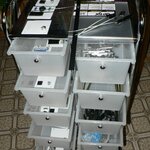
I am a firm believer that simulations improve reality. If you want to launch a CubeSat, you should start with a fictional CubeSat, a very small orbiting satellite concept. After deciding what you'd want to orbit the Earth (or Moon), you move to a 1:1 scale mockup. Only after you've broken a fair amount of plastic and fake hardware should you begin 'bending metal' on the real ones.
The process of prototyping and mockups is a standard part of engineering. The framework for doing so in an interesting manner is entirely based in the world of games.
The game framework is…

A 'Super Moon' - a new or full moon at 90% of its closest perigee - hasn't happened since...well, last year. But it's still cause for concern, according to people who need things to be concerned about.
The term 'Super Moon' was coined by Richard Nolle, an astrologer, in 1979. He believed they were significant and that only he had discovered them, thousands of years after ancient scientists noticed they happened.
A Super Moon is a full moon but because the moon's orbit is elliptical, it can look bigger when it's lunar perigee is closer, up to 14% bigger. It does have an impact -…
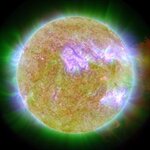
Check out this June 7th, 2011 eruption showing dark filaments of gas blasting outward from the Sun's lower right. The solar plasma appears dark against the Sun's bright surface but it actually glows at a temperature of about 18,000 degrees Fahrenheit.
When the blobs of plasma hit the Sun's surface again, they heat up by a factor of 100 to a temperature of almost 2 million degrees F. As a result, those spots brighten in the ultraviolet by a factor of 2 – 5 over just a few minutes.
The tremendous energy release occurs because the in falling blobs are traveling at high speeds, up to 900,…
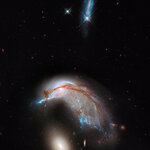
Arp 142 looks like the profile of a celestial bird but its imagery shouldn't overlook the fact that close encounters between galaxies are a messy business.
The interacting galaxy duo Arp 142 contains the disturbed, star-forming spiral galaxy NGC 2936, along with its elliptical companion, NGC 2937.
Once part of a flat, spiral disk, the orbits of the galaxy's stars have become scrambled due to gravitational tidal interactions with the other galaxy. This warps the galaxy's orderly spiral, and interstellar gas is strewn out into giant tails like stretched taffy.
Gas and dust drawn from the heart…
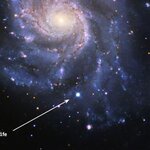
In August of 2011, astronomers witnessed the dazzling appearance of the closest and brightest Type Ia supernova since Type Ia's were established as the "standard candles" for measuring the expansion of the universe.
The visual of SN 2011fe was caught by the Palomar Transient Factory less than 12 hours after it exploded in the Pinwheel Galaxy in the Big Dipper. Because it was to see through binoculars, 2011fe was soon dubbed the Backyard Supernova. Major astronomical studies from the ground and from space followed close on its heels, recording its luminosity and colors as it rapidly brightened…

GPS is the first and most well known Global Navigation Satellite Systems (GNSS). It actually came out of the space race as it's forerunner was created to meet a need to track the first satellites launched. Today, GNSS is no longer just reserved for a few exclusive high-tech, high-cost applications, we all use this space-based geodetic tool when using our smart phones. Finding the best or the closest restaurant when visiting a new city or get direction driving from your hotel to your meeting location be it in a city you know or in a place you never visited before, our smart phone location and…

The gap between hypothesis and observation is never more evident than efforts to figure out howblack holes produce so many high-power X-rays.
Gas spiraling toward a black hole inevitably results in X-ray emissions; as gas spirals toward a black hole through a formation called an accretion disk, it heats up to roughly 10 million degrees Celsius. The temperature in the main body of the disk is roughly 2,000 times hotter than the sun and emits low-energy or "soft" X-rays. However, observations also detect "hard" X-rays which produce up to 100 times higher energy levels.
A group has…
David Brin first wrote this in 2006, summarizing a controversy that was then emerging among members of the community engaged in SETI, the Search for Extra-Terrestrial Intelligent civilizations. Since I am covering a new effort at METI - Messaging Extra-Terrestrial Intelligent civilizations - going online next week, he sent me this in our email exchanges and agreed to repost it here and provide a follow-up addendum at the end - Hank
SETI -- the Search for Extra-Terrestrial Intelligence -- has long occupied a unique niche in modern intellectual life, at the same time both widely popular and a…
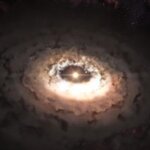
While the universe is littered with planets, comets and lots of other rocky bodies, how tiny grains of dust in the disc around a young star grow bigger and bigger, to eventually become rubble and even boulders well beyond a meter in size, is a mystery.
Computer models suggest that dust grains grow when they collide and stick together. However, when these bigger grains collide again at high speed they are often smashed to pieces and sent back to square one. Even when this does not happen, the models show that the larger grains would quickly move inwards because of friction between the dust and…

I am used to odd looks when I say I'm flying a satellite to convert the ionosphere to music. The field of art/science hybrids is hard to assess. What's your call on putting a TARDIS in space?
I call it a mash-up of current cultural trends. You've got the 'space for everyone' bit, the resurgence of Doctor Who, and the sponsor-my-flight bit covered in my earlier list of Kickstarter satellites. If they'd just added "for everyone" to their kickstarter title, they'd hit 4 trends and have a homer.
In the past, all space missions were about science. Science needs to a)…